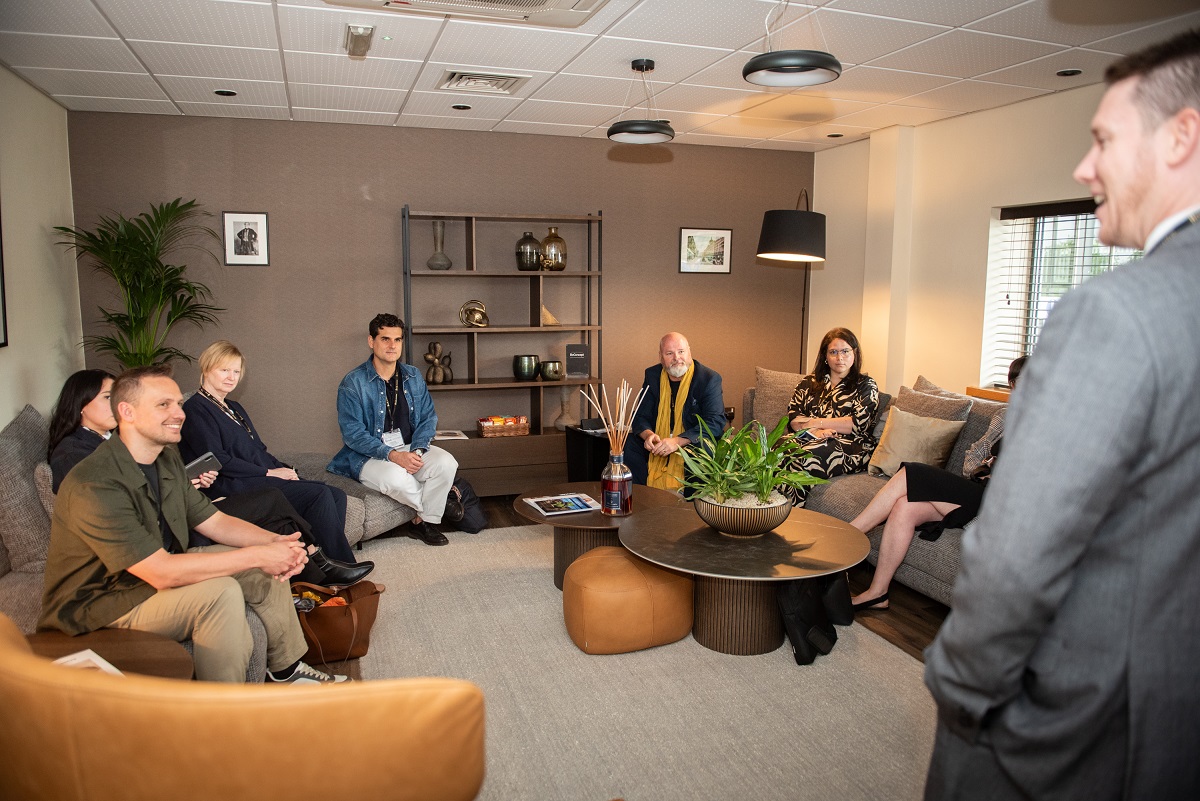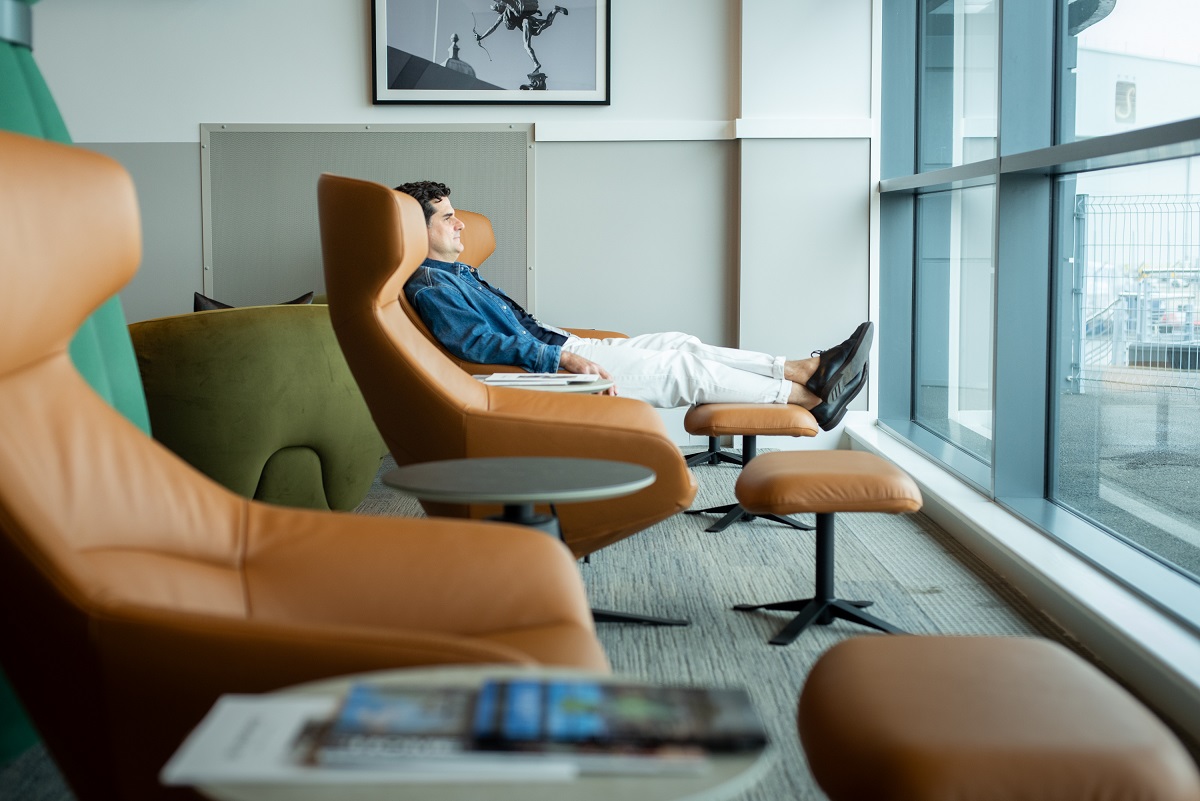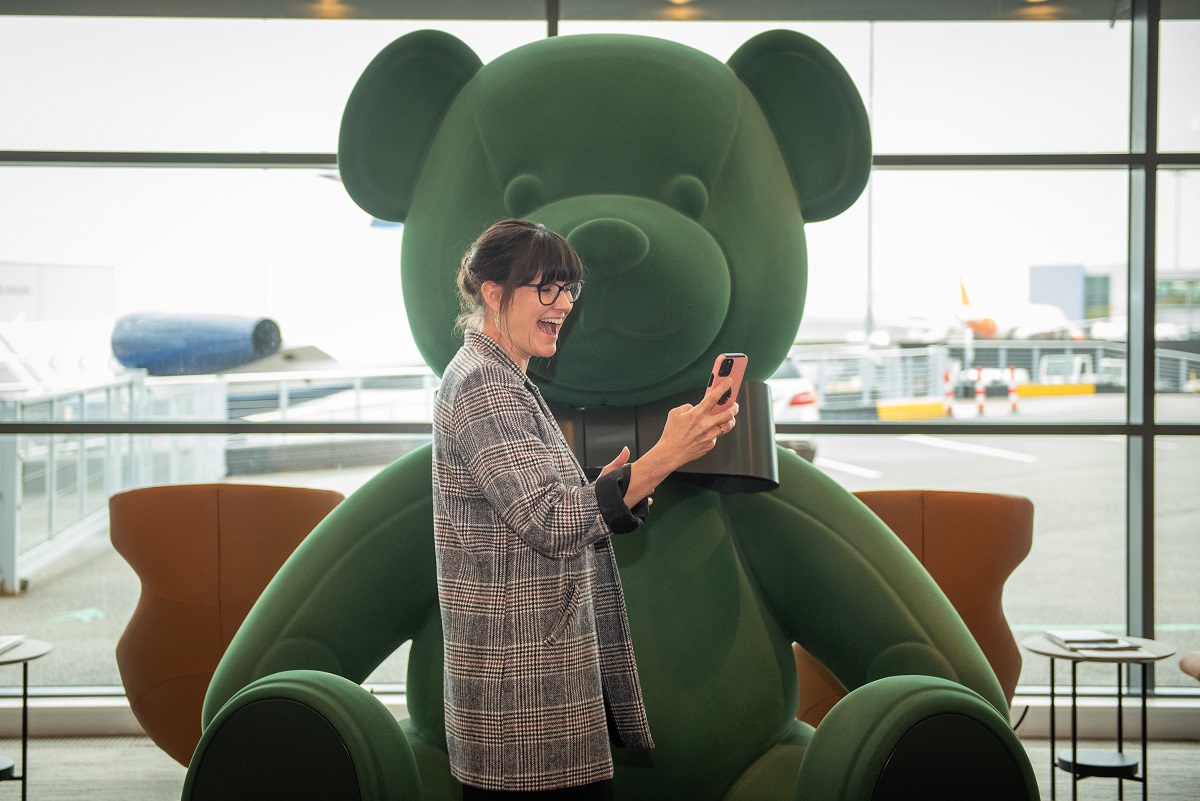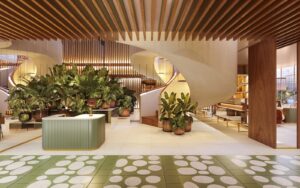Roundtable: Is there a place for premium and luxury retail brands in hospitality?
In collaboration with Danish furniture brand BoConcept, Hotel Designs Editor Sophie Harper co-hosted a discerning conversation alongside Michael Effenberger, Head of Business Development at BoConcept on the successful transition of high-end retail brands into the hospitality arena…

At the beginning of July, our roundtable attendees gathered at the exotic location of Luton Parkway to then travel in chauffeur-driven convoy to the very exclusive Harrods Aviation airport hangar.
During the roundtable, the group discussed their thoughts on high-end retail and luxury brands branching into the hospitality market to explore how the transition from one sector to another can be achieved successfully.
The conversation was followed by lunch and an exclusive tour of the hangar where plenty of ‘ooing’ and ‘aahing’ was heard from an appropriate distance from the private jets.

Our roundtable experts, from top left: Sophie Borel, Senior Design Manager, Cheval Collection; Neil Fairplay, Director, SparcStudio; Joseph Troughton, Associate Designer, David Collins Studio; Elizabeth Lane, Hospitality Design Consultant, JK Interiors; Shona Brannan, Designer, Design LSM; Nessma Alghoussein, Senior Architect, Chapman Taylor; German Mendoza, Senior Associate, WATG and Wimberly Interiors; Helen Gilbert, Creative Strategist, 3Stories
Prior to the conversation, our hosts for the day gave attendees a warm welcome and the opportunity to have a look around the lounge whilst getting acquainted with one another.
In one of the hangar’s private rooms, we kicked off the conversation by talking about different retail brands that had made the leap into hospitality. Fashion houses, Bulgari, Louis Vuitton and Versace were always going to be likely suspects branching into the hotel industry, but the group also discussed wild card retailers like IKEA, which opened its own hotel in the 1960s.
Helen Gilbert: If you’re trying to sell to people through your hospitality, I think it immediately becomes a bit garish. But if it’s about how you view the world and how you are delivering that experience, showing a desire to being part of that and you’re doing it with storytelling, people will engage with that. You create a guest experience and then you facilitate it – you decide how you want them to feel and create the environment around that, then retail can be integrated into that.
Neil Fairplay: I guess it must be easier for luxury brands like Louis Vuitton that are already associated with travel, it’s a more natural progression, but it always amazes me how loyal people are to certain brands, but if you don’t have the genetic background like Harrods does for hospitality in a retail environment or you’re not a hotelier, you could mess it up really quickly.
Sophie Harper: Do you think certain retail brands that already have a large following would find it easier to produce something like a hotel?
German Mendoza: Obviously it’s easier to attract existing followers of a brand. Fendi for example strategically opened a hotel next to their flagship store in Rome, but ultimately they have to be backed by an incredible hospitality experience, otherwise it’s not going to work.
Sophie Borel: Also it extends the client base to reach more people who perhaps can’t afford their more expensive products but they can afford a coffee and still feel as though they’re part of the lifestyle.
Shona Brannan: I think hospitality is another way for brands to spend time with their customers and that diversification within a brand is leveraging their reputation entering different markets, which is not necessarily new in the luxury sector, but expansion of the brand universe is what they’re doing, which is quite a modern trend. I think with a lot of these brands, it’s about capturing a lifestyle, so it’s more about working out how those luxury retail touchpoints can be translated into hospitality.
Neil: I think there’s a reverse trend as well, if you think about Soho House, they’ve now got their own furniture range – so they’re retailers now.
Shona: Yes, and guests can try the products out at the hotel, and then kind of take home the experience. You can buy the bed, or the linen and other things like that.
Sophie H: That’s true, but do you think people actually do that?
Elizabeth Lane: Absolutely! We’ve had clients get in touch from years ago who tell us they’ve had somebody stay who really loves the artwork and asks us where they can get it from – it’s been the same for a whole range of things. Beds are quite common because people say they’ve had the best night’s sleep, and they want to have the same experience at home.

Image credit: Emma Lambe Photography
Having spoken at length about branded hotels, the group were asked to share their ideas and personal experience of luxury brands complementing a hotel or hospitality space. The designers discussed different aspects of collaboration and how this could be beneficial to both hotel brands and retail brands.
German: I think it’s super appealing to luxury brands to collaborate with hotels. For example, the St Regis has a Bentley suite which we did ages ago, and you see that often in serviced apartments. Often ultra luxury apartments will get in touch with hyper luxury brands to develop suites – it’s almost like a tester for luxury brands to get into the hospitality world without the full commitment of having to deliver the service.
Helen: If you’re trying to expand your market and you have a consistent brand scape where you exist, blending those together is a good strategy to bring. Just now I was taking pictures of the hand soap in the bathroom, because I’m always interested to know which brands people use and are aligning themselves to. They’ve even put a little story together about why you’re putting this brand with that, because they have all these credentials – there’s a shared vision and values.

Image credit: Emma Lambe Photography
Attention turned to our co-host, Michael Effenberger, regarding the collaboration between Harrods and BoConcept for Harrods Aviation Lounge with the designers wanting to know more about how the partnership came about.
Michael: So we have a concession in Harrods. We’ve been there for more than 18 years, and we have become quite a prominent space within that furniture floor. I think our ethos, our brand recognition, who we are as a company and where our moral standings are, our Danish design complements quite nicely with Harrods.
They approached us directly at our concession and said they’d love the opportunity to see if we could put a proposal together against the Harrods interior design team. They knew we had the customisability, so we worked with them directly. We were able to customise the pieces with Harrods colours and produced the products to fulfil the furniture solution.
They were looking for a partnership, collaboration with a company that has international presence that would instil the idea of quality and comfort.

Image credit: Emma Lambe Photography
Passing the conversation back to the designers in the room, Michael asked: “When you’re designing for hospitality, are you designing experiential spaces or are you designing for comfort? Do you want people to feel at home, whether that’s the airport they fly from, the cruise they pick, or the hotel they stay in, or do you want to give them something new to experience?”
Joseph Troughton: Morris Lapidus, who was an amazing architect, his philosophy was not to design if it were someone’s house, people want to go to these places to experience something new. He designed to put people on a stage. He was the one who created the famous stairs to nowhere – the whole point of which was just to be seen going down the staircase in the hotel, the Fontainebleau in Miami. The stairs just led to a toilet, which was the most bizarre thing at the time, everyone asked why there was this elaborate staircase just to the restrooms, but it was so that people felt incredible and so everyone could see them make their arrival into the space.
I buy into that thinking. You should design so that people get to try something new that they don’t have at home. Give them something that changes their mindset and think ‘I want that’.
I think the reason we’ve been talking mainly about premium brands is because they’re the risk takers – the pioneers. Retail has evolved, you see it all along Bond Street, people aren’t buying things in their stores anymore, they’re going in for an experience.
Helen: There’s been a huge amount of blurring boundaries, and that extends to combining two things – for instance blending a coffee shop with a book shop, which attracts different customers who ultimately stay there for longer. It was always a natural progression for hospitality and retail to come together.

Image credit: Emma Lambe Photography
The room was divided though, with a number of designers addressing the need to find balance between offering a new experience and giving guests something they feel comfortable with.
Nessma Alghoussein: There’s something to be said about higher stress environments – like airports, for example. There will be a big portion of travellers who feel anxiety about going through security and would prefer to pay to go to a higher lounge, to be away from the crowds, the big machines and noise.
There’s balance to be found between comfort and the feel of home, and sometimes it’s a refuge. I think a lot of people, when they’re put in a situation where they’re overwhelmed with choice or where there’s too much going on, sometimes just kind of revert back to something they know, a brand that they’re comfortable with.
Sophie B: I want to challenge what was being said about hotels, because with serviced apartments these are guest’s homes, but the way we want them to experience luxury is by the way we receive them and the service the staff provide. We have really loyal guests, some of whom come back to us for 10/15 years. It’s having that level of luxury but is also being able to offer the feeling of ‘home’.

Image credit: Emma Lambe Photography
The group agreed that a balance needs to be struck, but that it really boils down to the target audience and business strategy as to whether a homely feel or experiential design should be utilised. What was clear though is that retail brands need to clear on being able to cater to the needs of the commercial sector if they’re going to be successful in the hospitality space.
Elizabeth: The problem is not everything produced for retail is suitable for commercial – there’s a whole different range of regulations – sorry to be the boring one! But it’s one of those big challenges, you can’t use domestic furniture in a commercial environment, the regulations are completely different, the same for use on ships, trains, again they’re all completely different.
Shona: It’s about brands being able to transition. It’s not necessarily the direct translation of manufacturing it and putting it in the space, but actually conceptualising and abstracting a few ideas from that brand in its essence. I think narratives are something that could be very easily transitioned into more hospitality spaces for these retail brands. It’s the fun bit where we get to try new ideas – I think the execution of the idea is probably the hardest part but potentially one of the most successful parts.
Drawing the conversation to a close, we concluded that there is indeed a place for premium and luxury retail brands in hospitality, but that retail brands looking to make their first forays into the hospitality sector need to be mindful of the differences between the two, whilst being able to capitalise on their shared values.
With thanks to Harrods Aviation and BoConcept for hosting the day’s events, and everyone in attendance.

Image credit: Emma Lambe Photography
Main image credit: Emma Lambe Photography





















